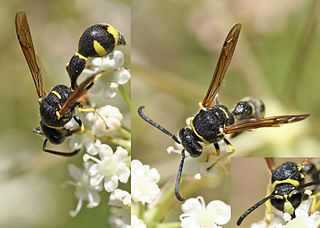
Eumenes is a genus of wasps in the subfamily Eumeninae. It is a large and widespread genus, with over 100 species and subspecies occurring worldwide. The genus was first proposed by Pierre André Latreille in 1802, with the type species later designated by Latreille in 1810. All species make jug-like nests out of mud, usually attached to twigs. The larvae are fed with caterpillars.
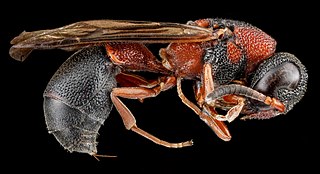
Leptochilus is a large, mostly Holarctic genus of small sized potter wasps. The genus reaches its largest diversity in the Palearctic where there are more than 135 species belonging to 5 subgenera. However the division of The division of Leptochilus into subgenera can not be fully supported and the status of some of them is dubious.

Anterhynchium is an Afrotropical, Indomalayan, Australian and Palearctic genus of potter wasps. As in many species of wasp, female wasps defend against predation using a modified ovipositor to sting predators. Like some other wasps in the Vespidae family, male wasps can produce a "pseudo-sting" with two sharp spines on either side of their genitals; however, unlike in the females, this "sting" is venomless.

Synagris is an Afrotropical genus of large potter wasps. Several Synagris wasps are strongly sexually dimorphic and males bear notable morphological secondary sexual traits including metasomal lamellar or angular protruding structures and hornlike or tusklike mandibular and/or clypeal projections.

Katamenes is a genus of potter wasps with species distributed in Europe and Africa. When originally named by Edmund Meade-Waldo, Katemenes was monotypic, containing only K. watsoni, but other species have since been moved from Eumenes to Katamenes.

Ropalidia is a large genus of eusocial paper wasps (Polistinae) in the tribe Ropalidiini distributed throughout the Afrotropical, Indomalayan and Australasian biogeographical regions. The genus Ropalidia is unusual because it contains both independent and swarm-founding species. Ropalidia romandi is one of the swarm founding species, meaning that new nests are founded by a large group of workers with a smaller number of inseminated females, while Ropalidia revolutionalis is independent-founding, meaning that each nest is founded by a single foundress.
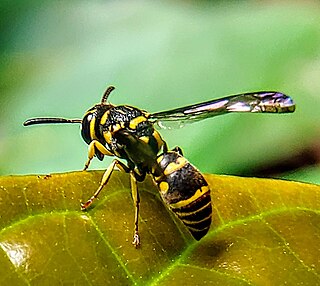
Stenodyneriellus is an Australasian and Indomalayan genus of potter wasps.
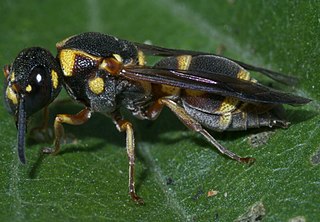
Stenodynerus is a rather large genus of potter wasps whose distribution spans the Nearctic, Palearctic, Oriental and Neotropical regions. Most of its species lack a transverse carina on the first metasomal tergum. A pair of medial pits on the anterior face of the pronotum and the expansion of the tegulae put this genus close to genera as Parancistrocerus, Hypancistrocerus and Eustenancistrocerus.
Knemodynerus is a genus of potter wasps distributed through the Palearctic, Afrotropical, Indomalayan and Australasian regions. The species currently classified in the genus are:
Leptomenes is a mainly Afrotropical genus of potter wasps. It was previously a much larger genus, though many species have been transferred to other genera such as Eumenidiopsis, Stroudia, and Tachymenes.
Eustenancistrocerus is an Afrotropical, Palearctic and Oriental genus of potter wasps. The species in this genus include:
Micreumenes is an Afrotropical genus of potter wasps with 30 described species.

Microdynerus is a genus of potter wasps in the family Vespidae.
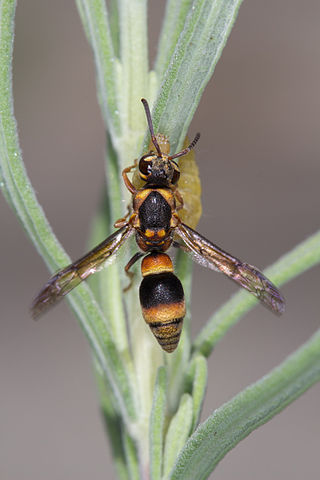
Paralastor is a very large Australian genus of potter wasps. Andrey sus

Pterocheilus is an essentially holarctic genus of potter wasps with a fairly rich diversity in North America and a single Afrotropical species Pterocheilus eurystomus Kohl 1906 known from Socotra. They are usually rather large wasps characterized by reduced tegulae and prominently pilose labial palpi.
Hemipterochilus is a Palearctic genus of potter wasps. It contains the following species:
Jucancistrocerus is a Palearctic genus of potter wasps. The currently species assigned to Jucancistrocerus are:
Onychopterocheilus is a Palearctic genus of potter wasps.










